Three ways operators can quickly increase network capacity
White Paper: By Martin Zimmerman
Abstract
Wireless operators are facing demand that pushes network capacity to its limits, particularly in densely populated urban areas where additional sites are difficult or impossible to secure. Recent innovations in small cells, particularly the newest capabilities of CommScope’s Metro Cell antenna solution portfolio, have opened up new avenues of capacity to these overburdened networks by leveraging new developments in densification, spectrum availability and overall efficiency—the three keys to boosting capacity quickly and economically.
- Densification: The newest Metro Cell antenna solutions are the most compact and versatile form factor on the market today. This makes them among the easiest to zone and install, providing a faster path for an operator to add a small cell layer underneath its macro network layer. Having more sites increases frequency re-use, which increases capacity.
- Spectrum: Recently, Federal Communications Commission (FCC) changes have opened up two new bands for conditional use by wireless operators—the 3.5 GHz Citizens Broadband Radio Service (CBRS) band and unlicensed 5 GHz band, both of which are supported by CommScope’s newest Metro Cell antenna solutions. The emergence of licensed assisted access (LAA) means both these bands can be brought into service for instant access to more spectrum.
- Efficiency: The new Metro Cell antenna solution also supports four-port operation for the incumbent 1.7–2.7 GHz and new 3.5 GHz bands, enabling 4X MIMO right out of the box. They also feature a unique radiation pattern envelope (RPE) that places nulls in different locations for each port, for total coverage. These factors directly increase network efficiency by moving more data per Hertz and providing better coverage per cell. Combined, these benefits create a compelling case for operators to consider CommScope’s new Metro Cell antenna solutions as they execute their capacity strategies.

CommScope’s advanced Metro Cell antenna solution
The second key element of increasing network capacity is the availability of spectrum. Current and growing demand has wireless operators scrambling to increase the spectrum available to their networks, and the recent release by the FCC of conditional access to both the 3.5 GHz citizens band radio system (CBRS) and unlicensed 5 GHz band commonly used by applications such as Wi-Fi networks has created a rare and valuable opportunity for networks to expand the bandwidth available to them—if they have the technology to successfully leverage these newly available bands. Here also, the VVSSP-360S-F Metro Cell antenna solution provides immediate access to enhanced capacity. The antenna supports established LTE bands in the 1.7–2.7 GHz band, and also natively supports the 3.5 GHz CBRS and 5 GHz unlicensed band.
Three ways to address one big challenge: increasing capacity
Wireless operators are feeling the capacity crunch like never before. Even as the number of subscribers has leveled off, the amount of data moved over networks continues to explode. The effects are most pronounced in densely populated urban areas, where the higher concentration of demand is exacerbated by a lack of suitable cell sites. Opportunities and locations to add more macro cell sites are very few, and strict zoning regulations have made many small cell sites unavailable for all but the smallest, most unobtrusive solutions.
The answer to the capacity crunch is, in fact, three answers: network densification, increased spectrum and improved per-site efficiency. Fortunately for wireless operators, CommScope now offers a breakthrough solution that addresses all three needs with a new Metro Cell antenna solution. This new alternative presents a compelling case for consideration by operators racing to increase network capacity quickly, effectively and economically.
Densification by stealth
The most direct means of increasing network density—and hence, capacity—is by the addition of more small cell sites in the covered area, which allows for greater spectrum re-use. The challenge here is that deploying great numbers of small cells can easily run afoul of local zoning ordinances and other size or appearance restrictions. In addition, these restrictions can put operators into an impossible compromise between size and performance, limiting the capacity benefits of those small-cell sites that can be deployed.
CommScope’s newest VVSSP-360S-F Metro Cell antenna solution addresses this challenge by stealth. At two feet in length and eight inches in diameter, the VVSSP-360S-F Metro Cell antenna is the slimmest, most compact small cell solution available today with its capabilities and port counts. Because of its slim profile and unobtrusive appearance, it is compliant with more zoning restrictions and, therefore, it dramatically increases both the number and diversity of site locations available to an operator as they add a small-cell layer underneath the macro network.
The VVSSP-360S-F antenna is part of CommScope’s fully-featured integrated Metro Cell solutions, which are available with fiber or microwave backhaul capabilities. Designed for maximum versatility, the VVSSP-360S-F solution can be affixed to street lights or virtually any vertical street furniture. This adaptability provides operators with superior small-cell network design freedom as it solves the challenges of most zoning restrictions.
On a broader scale, the Metro Cell concealment solution portfolio also includes dedicated street furniture featuring integrated Metro Cell technology—including the antenna—in the pole’s base, middle or top, further increasing the options available for new deployments. Because this form factor is inherently easier to permit, operators can increase network density in more locations. The availability of integrated pole solutions also allows for faster and more consistent deployments, putting extra network capacity into market sooner and more economically.
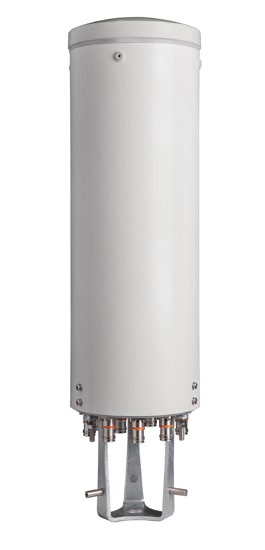
The VVSSP-360S-F Metro Cell antenna, the smallest on the market today.
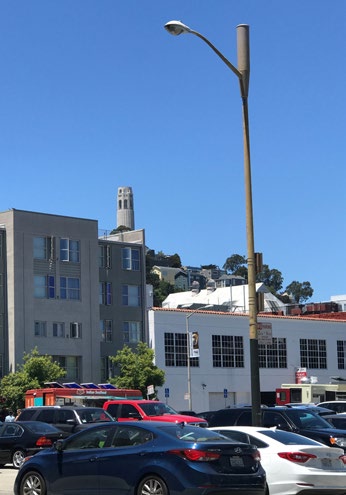
Can you spot the Metro Cell deployment in this picture?
Support for new spectrum
The second key element of increasing network capacity is the availability of spectrum. Current and growing demand has wireless operators scrambling to increase the spectrum available to their networks, and the recent release by the FCC of conditional access to both the 3.5 GHz citizens band radio system (CBRS) and unlicensed 5 GHz band commonly used by applications such as Wi-Fi networks has created a rare and valuable opportunity for networks to expand the bandwidth available to them—if they have the technology to successfully leverage these newly available bands.
Here also, the VVSSP-360S-F Metro Cell antenna solution provides immediate access to enhanced capacity. The antenna supports established LTE bands in the 1.7–2.7 GHz band, and also natively supports the 3.5 GHz CBRS and 5 GHz unlicensed band.
- 3.5 GHz is federally-controlled shared spectrum that holds a strict hierarchy of access priority, with the U.S. military at the top of the list, followed by Priority Access Licensed (PAL) users and General Authorized Access (GAA) users. With the inclusion of a spectrum access system (SAS) solution that automatically mediates multiple signals and observes the required priority levels to avoid interference—particularly in areas away from bodies of water (the military uses the band primarily for ship-based radar) operators can tap into 150 MHz of new bandwidth in this band.
- 5 GHz comprises the Unlicensed National Information Infrastructure (U-NII) band, which is used by many unlicensed radio applications, including 801.11ac Wi-Fi networks found virtually everywhere in the United States. It covers the range from 5.150 to 5.925 GHz—potentially adding 775 MHz of available spectrum.
While the availability of the 3.5 and 5 GHz bands presents an exciting opportunity for increased network capacity, several key obstacles still exist. The 3.5 GHz band requires the use of a SAS solution in order for an operator to comply with CBRS access priority regulations. The 5 GHz band (and some 3.5 GHz applications) require the addition of a licensed assisted access (LAA) solution in order to integrate the site with the macro network. Another obstacle is the fact that operators will need to add antennas and ports in order to use these new bands, which introduces significant logistical and cost challenges, particularly in small cells that are already strictly limited in size and appearance by zoning. Here, the VVSSP-360S-F Metro Cell antenna solution provides a simple, compact and highly economical solution. It supports 3.5 GHz (four ports) and 5 GHz (two ports) in addition to the PCS, AWS, WCS and BRS bands already in general use (four ports). Just as importantly, the VVSSP-360S-F Metro Cell antenna solution is fully FCC Part 15 compliant for the 5 GHz band. This regulation requires that the antenna display these characteristics:
- <6 dBi antenna gain
- Effective isotropic radiated power (EIRP) suppression 30 degrees above the horizon of <125 mW (21 dBm) (Applies to UNII 1 band only)
CommScope engineered this compliant solution with the use of innovative patent-pending technology that improves signal focus and yield EIRP figures and RPE that avoid interference and increase the utility of the 5 GHz band.
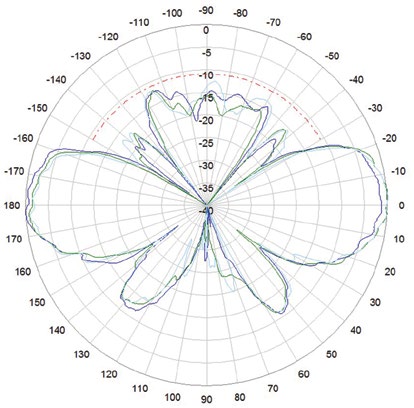
VVSSP-360S-F EIRP, compliant with FCC Part 15
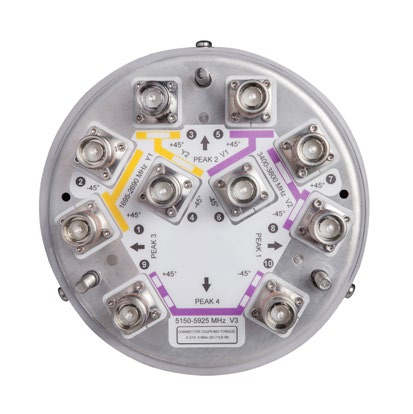
Out-of-the-box connectivity for 3.5 and 5 GHz bands
Boosting efficiency
These features of the VVSSP-360S-F Metro Cell antenna solution also have the effect of increasing efficiency over all covered spectrum, not only in the 3.5 and 5 GHz bands. The four-port configuration for established 1.7–2.7 GHz LTE bands supports MIMO operation, which increases the amount of data that can be carried within a given band.
In four-port operation, the VVSSP-360S-F Metro Cell antenna solution employs a unique “orthogonal peanut” pattern diversity approach that increases coverage within the cell and improves quality of service by offsetting pattern nulls between the four ports. Previous four-port antennas typically displayed nulls in the same position across all four ports; by adopting two orthogonal bidirectional patterns, the VVSSP-360S-F Metro Cell antenna solution covers the nulls and eliminates dead spots. In practice, this solution increases not only coverage but capacity as well due to its enhanced efficiency.
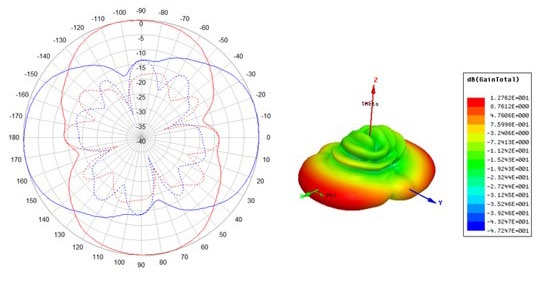
The “orthogonal peanut” spatial multiplexing pattern diversity virtually eliminates nulls.
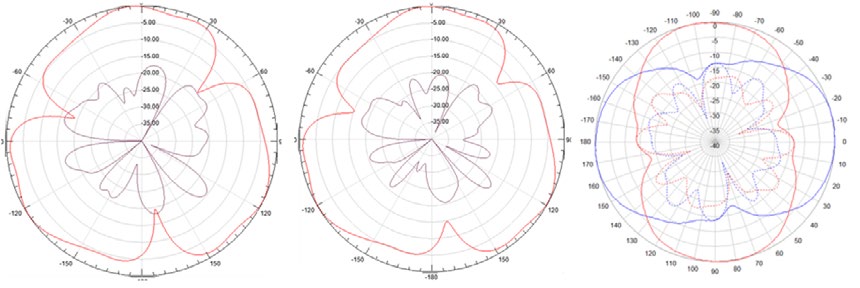
Comparison of simulated side-by-side, vertically stacked and Metro Cell patterns—note the reduced nulls and more efficient coverage pattern yielded by the Metro Cell antenna’s orthogonal bi-directional pattern.
This pattern diversity—called spatial multiplexing—provides slightly increased capacity over side-by-side designs and significantly increased capacity over vertically stacked designs, with similar overall antenna heights. It also supports real-time beamforming and suppressed sidelobes, improving interference discrimination and reducing power use. Simulations of the VVSSP-360S-F Metro Cell antenna solution clearly reveal this increased efficiency.
This increased capacity comes in a footprint that is smaller than side-by-side configurations (requiring four columns around the reflector instead of the usual six), which is part of what makes the VVSSP-360S-F Metro Cell antenna solution so much easier to deploy where zoning and aesthetic considerations are limiting factors.
Conclusion: the fastest way to more capacity
Wireless operators can improve their competitiveness by increasing network capacity—particularly in densely populated urban areas—through a strategy that leverages new developments in densification, spectrum availability and overall efficiency. Much of this capacity battle is being fought in the small-cell space, where CommScope’s VVSSP-360S-F Metro Cell antenna solution provides significant advantages across all three elements.
- It assists densification efforts by being small enough to deploy almost anywhere
- It leverages new spectrum with out-of-the-box support and FCC compliance
- It enhances efficiency with an innovative pattern and improved coverage characteristics
Soon, CommScope will be releasing new variants on the VVSSP360S-F Metro Cell antenna design that will add options for different port counts, expanding MIMO opportunities and further increasing practical deployment options for operators. In conclusion, the VVSSP-360S-F Metro Cell antenna solution from CommScope should be included in every wireless operator’s immediate and longterm network capacity strategy.

Prior to that, he worked as an antenna engineer for Sinclair Technologies and Analex, a NASA contractor. Martin holds 28 U.S. and numerous foreign patents in addition to having been published in several journals. He has a BS in electrical engineering from California Institute of Technology and an MS and PhD in electrical engineering from University of Illinois, Urbana-Champaign.
